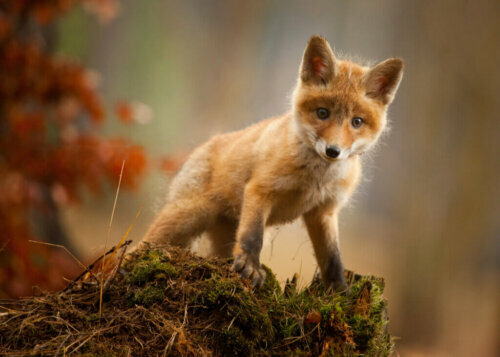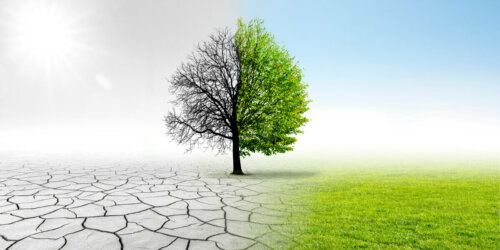The Earth's Sixth Mass Extinction of the Holocene

A large number of animal species are disappearing from the face of the Earth, and estimates indicate that about 150 animal species disappear every 24 hours. Some take it as evidence that the sixth mass extinction of the Holocene is unstoppable. There are various causes and almost all have to do with human activity.
What is causing the mass extinction of the Holocene? What species are affected by it? Can humans prevent it? Read on to find out the answers to these questions and more.
The sixth mass extinction
According to scientific data: the Earth is already undergoing the sixth mass extinction in history. This isn’t the first catastrophic episode in terms of loss of diversity and there have been many mass extinctions.
95% of marine species disappeared during the Permian-Triassic period extinction (250 million years ago), including the trilobites. Then, dinosaurs disappeared forever 65 million years ago — at the end of the Cretaceous period.
Every single one of these extinctions changed life on the planet forever. So, how do we know we’re undergoing the mass extinction of the Holocene?

The sixth mass extinction
The Holocene mass extinction is named after the geological period in which it occurred, approximately 12,000 years ago.
The main cause is human activity, no doubt. Due to the expansion of homo sapiens around the world – 40,000 years ago – the permanence of most species on Earth has been threatened.
- The massive hunting of large animals leads to their extinction. Humans began to hunt for food when we appeared, and this led to the population decline of many animals. This eventually led to the disappearance of species such as the mammoth or the auroch.
- Many habitats disappeared due to human activities – agriculture, mining, construction, logging, and many other activities that are harmful to the world’s ecosystems.
- There’s been climate change since the late nineteenth century due to the emission of greenhouse gases into the earth’s atmosphere.
As you can see, all of the things mentioned above are about human intervention in one way or another. Our species expanded and took over the planet over many centuries, and, of course, severely damaged the various natural ecosystems.
Thousands of threatened species
According to many studies, the current extinction rate is 100 to 1000 times higher than the natural average. Thus, this reflects how dramatic the loss of species can be.
There’s definitely a cause for alarm. For instance, according to one article, the International Union for Conservation of Nature (IUCN) reports that many species are currently endangered – one in eight species of birds, one in four mammals, and one in three amphibians.
Many of these species are threatened by the effects of climate change. This is because global warming leads to drastic shifts in temperature and rainfall patterns and many animals aren’t prepared for it. For example, polar bears are losing their habitat due to the disappearance of the Arctic ice floe.
As you can see, climate change and habitat loss are the main challenges animals are facing. The disappearance of the rain forests, the most diverse ecosystem, is leading to the loss of thousands of species, orangutans among them.
The Holocene’s mass extinction is an ancient process
People usually think of relatively recent events caused by human beings when talking about the sixth mass extinction. Such is the case of the dodo – which disappeared in the 17th century – or the Yangtze River dolphin, considered extinct in 2008.
However, we shouldn’t forget that there have been mass extinctions for thousands of years. 33 genera of large mammals, out of the 45 present at that time, perished due to climate causes during the prehistoric American extinction.
Can humans prevent it?
Given the dramatic nature of some estimates, it’s normal to be frustrated and think there’s nothing we can do about an extinction event of this magnitude. This isn’t so; in fact, there’s still time to prevent the mass extinction of species.
For one, we must change certain socioeconomic patterns even if the process isn’t easy. It can be as follows:
- Prioritize sustainable management of the natural environment by avoiding the over-exploitation of resources. We must stop destroying the ecosystems, because we all depend on them.
- Fight against climate change by gradually reducing – and eventually eliminating – greenhouse gas emissions. It’s the only way to protect the world species from the adverse effects of global warming.
- Intensify the protection of the natural environment by preserving areas where nature can take its course without human intervention.

In conclusion, we must be aware that it’s still possible to prevent the mass extinction of species if we implement appropriate policies despite it being difficult. We all can still reverse this critical situation.
All cited sources were thoroughly reviewed by our team to ensure their quality, reliability, currency, and validity. The bibliography of this article was considered reliable and of academic or scientific accuracy.
- Extinción masiva del Holoceno. (2020, 15 de septiembre). Wikipedia, La enciclopedia libre. Fecha de consulta: 16:06, octubre 7, 2020 desde https://es.wikipedia.org/w/index.php?title=Extinci%C3%B3n_masiva_del_Holoceno&oldid=129289480.
- Galus, C. (2008, 13 agosto). La sixième extinction des espèces peut encore être évitée. Le Monde. https://www.lemonde.fr/planete/article/2008/08/13/la-sixieme-extinction-des-especes-peut-encore-etre-evitee_1083195_3244.html</p;>
